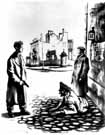
|
|
|

|

|

|

|
|
Click on an image to see a larger, more detailed picture.
|
|
|
|
|
| 1942: The "Final Solution" |

|
pg. 381 |

|
|
|
|
| |
 Although the Nazis employed threats and violence to destroy the underground press, courageous residents of the Warsaw Ghetto persevered. In this pamphlet illustration, a youthful Jewish fighter aims his gun at a Nazi officer. Hoping to instill defiance and fan the flames of resistance, the pamphlet proclaimed: "Nazis dare not travel alone in the streets."
Although the Nazis employed threats and violence to destroy the underground press, courageous residents of the Warsaw Ghetto persevered. In this pamphlet illustration, a youthful Jewish fighter aims his gun at a Nazi officer. Hoping to instill defiance and fan the flames of resistance, the pamphlet proclaimed: "Nazis dare not travel alone in the streets."
Photo: Corbis-Bettmann
|
 The Ukrainian town of Mizoch contained a relatively small ghetto of 1700 Jews. But when the Germans attempted to liquidate the ghetto in mid-October 1942, they met a brief but determined resistance from the inhabitants. In the end the ghetto was successfully liquidated. Among those executed south of the nearby town of Rovno by Ukrainian and German police were these naked Jewish women, a few of whom were holding infants. Often, babies were not shot but were buried alive with their mothers.
The Ukrainian town of Mizoch contained a relatively small ghetto of 1700 Jews. But when the Germans attempted to liquidate the ghetto in mid-October 1942, they met a brief but determined resistance from the inhabitants. In the end the ghetto was successfully liquidated. Among those executed south of the nearby town of Rovno by Ukrainian and German police were these naked Jewish women, a few of whom were holding infants. Often, babies were not shot but were buried alive with their mothers.
Photo: Yad Vashem / United States Holocaust Memorial Museum Photo Archive
|
 Some victims of Nazi Aktionen survived the final shooting. This photo shows one of the German policemen shooting women who were still alive after the mass execution of Jews in Mizoch, Ukraine. It was not unusual for the perpetrators to take photos such as this one. A German policeman named Hille, who took this photo and others, gave them to a lawyer in Czechoslovakia, where Hille had settled after the war. In 1946 the Czech government seized the photos, which eventually became public.
Some victims of Nazi Aktionen survived the final shooting. This photo shows one of the German policemen shooting women who were still alive after the mass execution of Jews in Mizoch, Ukraine. It was not unusual for the perpetrators to take photos such as this one. A German policeman named Hille, who took this photo and others, gave them to a lawyer in Czechoslovakia, where Hille had settled after the war. In 1946 the Czech government seized the photos, which eventually became public.
Photo: Main Commission for the Investigation of Nazi War Crimes / United States Holocaust Memorial Museum Photo Archive
|
|

|

|

|

|
 October 25, 1942: Germans demand that Oszmiana, Lithuania, give up 400 of its 1000 Jews. The selection of the victims is assigned to the Jewish police in the nearby city of Vilna. Vilna Ghetto leader Jacob Gens decides to hand over Oszmiana's elderly Jews in order to save the others.
October 25, 1942: Germans demand that Oszmiana, Lithuania, give up 400 of its 1000 Jews. The selection of the victims is assigned to the Jewish police in the nearby city of Vilna. Vilna Ghetto leader Jacob Gens decides to hand over Oszmiana's elderly Jews in order to save the others.
|
 October 27, 1942: Three thousand Jews are deported from Opoczno, Poland, to the Treblinka death camp. A few who escape to forests nearby form a partisan group, the Lions.
October 27, 1942: Three thousand Jews are deported from Opoczno, Poland, to the Treblinka death camp. A few who escape to forests nearby form a partisan group, the Lions.
|
 October 27-28, 1942: Seven thousand Kraków, Poland, Jews are deported to Belzec; 600 are killed in Kraków.
October 27-28, 1942: Seven thousand Kraków, Poland, Jews are deported to Belzec; 600 are killed in Kraków.
|
 October 28, 1942: The first transport from Theresienstadt, Czechoslovakia, arrives at Auschwitz.
October 28, 1942: The first transport from Theresienstadt, Czechoslovakia, arrives at Auschwitz.
|
 October 28, 1942: Sixteen thousand Jews are murdered at Pinsk, Poland.
October 28, 1942: Sixteen thousand Jews are murdered at Pinsk, Poland.
|
 October 28, 1942: Mieczyslaw Gruber, a Jewish former soldier in the Polish Army, escapes with 17 others from a Nazi POW camp on Lipowa Street in Lublin. The group will later establish a partisan group in the forest northwest of the city.
October 28, 1942: Mieczyslaw Gruber, a Jewish former soldier in the Polish Army, escapes with 17 others from a Nazi POW camp on Lipowa Street in Lublin. The group will later establish a partisan group in the forest northwest of the city.
|
|
|
|
|
| 1942: The "Final Solution" |

|
pg. 381 |

|
|
The Holocaust Chronicle
© 2009 Publications International, Ltd.
|
|
